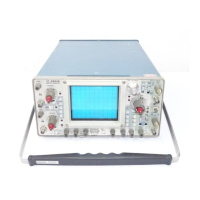Theory of Operation—465B Service
amplifier. In the GND position of S30A, the signal path is
opened and the input
of the amplifier is connected to
ground through R3015.
This
provides aground
reference
without the need to disconnect the applied signal from the
input connector. Resistor R3014 is a
high resistance
connected across Input Coupling switch S30A, which
allows C13012 to be precharged when the switch is
in the
GND position. Therefore the trace remains within the
viewing area of the crt when the switch is placed in the AC
position.
Input
Attenuator
The effective overall deflection factor of each vertical
channel of the 465B is determined
by
the setting of the
Channel VOLTS/DI V switch The basic deflection factor of
the Vertical Deflection System is 5 millivolts/division of crt
deflection. To achieve the
deflection factor valuce marked
on the front
panel,
precision attenuators
areswitched into
the input to the Vertical
Preamplifier circuit.
For VOLTS/DIV switch positions above 5 millivolts,
frequency compensated-voltage dividers (attenuators)
are switched into the circuit to produce the vertical
deflection factors indicated on the front panel Each
channel has a 2X, 4X, 10X and 100X attenuator which may
be selected in various combinations A constant attenua-
tion is provided at all frequencies within the bandwidth
range
of
the instrument. The Input Attenuators are
designed to
maintain
the same input
characteristics
(1
megohm and
approximately
20
picofarads)
for each
setting of the VOLTS/DIV switch Each attenuator con-
tains an adjustable
series
capacitor to
provide correct
attenuation at high frequencies and an
adjustable
shunt
capacitor to provide correct input capacitance.
NOTE
Each attenuator is
a
hybrid encapsulated plug-in
assembly
;
therefore, replacement of individual com-
ponents within the attenuator is not
possible
Should
defects
occur, the attenuator must
be
replaced
as a
unit.
Source Follower
The Channel 1 signal from
the input attenuator is
connected
to Source
Follower
Q1297A through R3042,
C3042,
and R3045 Resistor R3039
provides the input
resistance
and
resistor
R3045 functions as
a
damping
resistor
Q1297B is a constant current source for Q1 297A
Q1297A and B provide a high input impedance
for the
attenuators
and the current drive
needed for the First
Amplifier.
In
the event that
excessively high-amplitude
signals are
applied to Source Follower
Q1297A, the signal will
be
limited
by
CR1298 and
the
gate-source
junction of
Q1297A If the negative signal amplitude
causes CR1298
to become forward biased, Q1297A gate
is
clamped
to
approximately
—8.7
volts Excessive positive
signal
amplitude will forward bias the gate-source junction
of
Q1297A. As soon as gate current flows,
the gate voltage
will cease increasing
Gate
current
is
limited
to a safe value
by the high resistance of
R3042.
First Amplifier
The First Amplifier stage
is an integrated
emitter-
coupled, push-pull, cascode
amplifier
U1290.
The input
signal on pins
13 and 16 is converted from a single-ended
signal
to a
push-pull signal
by a
paraphase amplifier and
then is fed to the common base
output stage to produce
the current drive
to
Q1175
and
Q1375. The CH 1 VAR
VOLTS/DIV control, which is connected to
pin 11 of
U1290,
varies the gain of the First Cascode
Amplifier
stage.
This control provides variable vertical deflection at
each position of the VOLTS/DIV switch.
With
the
VAR
control in its calibrated detent (wiper at ground),
the A and
D output
transistors of U1 290 are
conducti ng The B and C
output
transistors are biased off. Thus,
the signal current
available to the following amplifier stage
is the collector
current
flowing in output transistors
A and D
When the VAR control is rotated
out
of its calibrated
detent,
the B
and
C
output transistors of
U1290 begin to
conduct
by an
amount determined
by the
position
of the
VAR
control.
This causes two events to occur:
1. The signal current flowing in the A and
D
output
transistor is
reduced by the amount of
signal
current
flowing in the B and
C
output transistors
2. Output transistors A
and C
and output transistors B
and D conduct current of opposite polarity
The output of
transistor
C
is added to the output of transistor
A to reduce
the signal current available
at pins 5 and
6,
and the output
current of transistor B is
added to the output current of
transistor Dto reduce the signal
current available at pi ns 8
and 9.
The component values selected
for the variable func-
tion provide a variable attenuation ratio of approximately
2
5 to 1 Channel
1
Variable Balance adjustment R1484is
adjusted
so
that no trace shift in
the display occurs when
rotating the VAR control. When
the
Channel
1 VAR
control is out of its calibrated detent the Channel
1 UNCAL
LED
is
illuminated The components connected
between
pins 2 and
3
of U 1290 provide frequency
compensation for
the stage
REV
A JUN 1979
3-5

